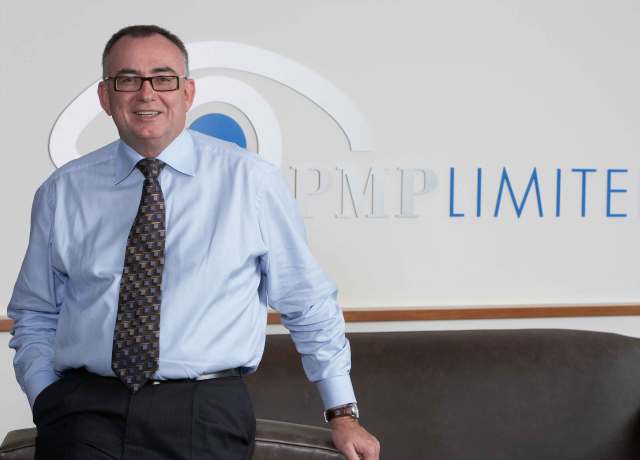
July was a good month for Richard Allely. The man in the top job at PMP took his place on the board of the PGA of Australia. “For me, golf is a passion,” says Allely, looking out from his 12th-floor corner office, shelves lined with golfing trophies. “I haven’t got anywhere to put them in my house – my wife won’t let me,” he smiles.
If July was good, the following month wasn’t too bad either. PMP has descended to the depths and climbed out again, with Allely holding the lead rope. The former chief financial officer has presided over a turnaround of epic proportions in the year-and-a-half since he took over as chief exec.
In August, the publicly listed printing giant revealed its full-year figures, with a huge swing back into the black. Its profit after significant items for this financial year was $20.6m. That’s a $47.2m increase from last year’s loss. “We’ve gone from strength to strength. It just proves the theory that CFOs make the best CEOs,” laughs Allely.
He should be happy – and relieved. The billion-dollar trans-Tasman group had a true annus horribilus in 2009. First came the departure of then chief executive Brian Evans. The real blow came in June when the ACCC revealed it was investigating what came to be known as the “distribution rorts”. Some of PMP’s delivery figures were incorrect. Customers turned tail.
Throughout the first half of 2009, PMP was rarely out of the headlines, for all the wrong reasons. The Age, 9 February 2009: “Struggling PMP scraps dividend”. The Australian, 17 April: “PMP bleeds profits and staff”. The Australian Financial Review, 25 June 2009: “PMP admits to deception over junk mail delivery”. Sydney Morning Herald, 26 June 2009: “Client sues PMP over undelivered papers”.
With Allely out front, the company took the flak head on. It admitted to the flaws in distribution. Allely announced a “transformation plan”. He claimed he would turn PMP into a “much easier business to do business with, a business that connects on a very honest and a very open relationship”.
Phrases like “transformation plan” or “restructure” have been getting thrown around by most big print groups over recent years as they try to come to grips with the market upheaval. Often these strategies are met with scepticism by the wider industry. But PMP’s strategy has proved itself. The turnaround is right up there for all to see on the ASX. How did Allely find the right formula to transform PMP’s fortunes?
“It is having a positive effect because we started with the fundamental building blocks of our culture and that really started with getting the right team to run the company,” says Allely.
New team
With his ascent to the top job, the old guard was swiftly replaced with a new team. “Back in early 2009, I switched out the entire executive team. Everyone on that team is new to their role. We only just competed the make-up of that team with the hiring of Geoff Stephenson as CFO a matter of weeks ago. It started with fundamentally getting the right team of people around the table, and I have to say that all of those people are the best managers that the industry has to offer.”
That was step one. “The next thing was to identify significant restructuring savings that were hard-wired. In other words, the tasks, the activities, the programs, the initiatives that we ran were all hard wired to the bottom line. So we knew that by taking a certain action, we absolutely understood the impact that would have in terms of the bottom line earnings. And we also understood what it would do long-term in an operational sense in terms of business efficiency and effectiveness.
“Our transformation plans was, quite frankly, run by people who knew what they were doing. Every start and finish date was managed program-managed with precision,” says Allely.
“You can see the results it has delivered to a business that is posting revenue decline through loss of market share and walking away from unprofitable work – which is a key decision we’ve made – but has generated a bottom line uplift in earnings at the operating level of over 30%.”
In fact, PMP’s pre-tax earnings were up 39.5%, to $36.9m, despite, as Allely points out, a 9.9% fall in revenue from $1.35bn to $1.21bn. Again and again, he comes back to this conscious move away from low-margin work. In the current fervid debate over price-cutting, it’s refreshing to talk to someone who can look at a loss of work with pride rather than regret.
“We had high-profile retailers that drove a program of reducing their print costs to a point where as the market leader, we took a view that it would be economically value-destroying for someone to take on that work at that price,” says Allely.
“We made a conscious decision not to put a price on the table to secure the work and unfortunately – or fortunately, depending on your perspective – that work was picked up by one of our competitors. With the benefit of hindsight, they may rue the day they took that work on.”
PMP plays with the big boys of buying, in the upper echelon of procurement where intense price-competition seems to be hitting hardest. If you listen to complaints from many printers, corporate procurement teams are squeezing suppliers for every penny. Only last month, it was revealed that after 15 years with IPMG, Qantas had moved its print management contract to TMA, a supplier relative unknown within the commercial printing sphere. In the simplest of terms, IPMG chief executive Stephen Anstice blamed this on unfeasibly low price requirements.
Price squeezing
Does Allely think the corporates are getting worse when it comes to pushing down on price?
“I don’t think we’re seeing anything new. The procurement houses that belong to the big brands have never changed. Their mandate is to get more for less. There is a reality that bites at some point in printing. These are capital-intensive businesses. If you don’t get a sufficient economic return to support the capital intensity and productive capabilities, I can assure you the end is in sight,” he says.
“We are not prepared to see short-term gain by winning a gain at a low price that will become a longer-term pain because we are not developing the cash flows you need to reinvest in productive capabilities to support clients,” says Allely.
“It’s easy to state those words but much harder to look at a contract and say no. I have presided over a few no’s. It’s funny but some of the ones we said no to – not all but some part of that volume – have crept back in but at a better margin,” he adds.
It’s a telling statement about the current state of price negotiations that even buyers sometimes realise work cannot be produced at such low price points. Could it mean margins will start creeping back up? It’s an unequivocal no from Allely. “I’m not predicting that market price will improve or that volumes will increase.”
Growth is going to have to come from within PMP. “I think we can continue to seek out and find more efficient and productive ways of doing things. Our earning upslide and our ability to compete in these product markets will largely come about because of our level of efficiency and maintaining very high quality at a price that competitors will struggle with.”
In these full-year figures, PMP’s Print division, which contributes roughly 40% of the group’s overall revenues, posted earnings before interest, tax and significant items (EBIT) of $47.7m, a 39.3% increase despite a fall in revenue of 13.4%. This drop in revenue was in line with a volume reduction of 13.7% year-on-year.
The Print division is on the right track, with Woolworths recently renewing with PMP for 100% of its heatset work across Australia and New Zealand. But Allely didn’t just take the work whatever the cost. In fact, he made it clear he would only take on the contract if he got all of it. “With the big clients, getting half or 30% of their work doesn’t work for me because of our capital intensity,” he said at the time.
The biggest story surrounding PMP Print has circled since 2008, when publishing giant PBL, parent of ACP, announced plans to build its own print and distribution plant, a 200-staff, 54,000m2 plant in Sydney’s western suburbs. Many were incredulous about the idea – was there any sense in making a massive investment in printing infrastructure in a market already failing to fill its existing capacity?
There was an feeling from some quarters of the market that ACP was playing a game of chicken on a grand scale, hoping to drive down prices by threatening to take its print spend in-house. In the end, the plan never came to pass, and PMP retained the ACP work.
But was it all a bluff? A report in the Financial Review said: “PBL Media… had now reached new, lower pricing terms with PMP and other printers”. In an online poll at the time, ProPrint asked: “How likely was it that ACP would have built its proposed printing plant?” Some 70% of respondents answered: “Unlikely. It’s more likely they wanted existing print suppliers to drop prices.”
Allely says he never doubted that ACP was ready to go through with the plant. “I always took the view that these guys were very serious about going ahead with their desire. Hence the dilemma I’ve always had is that while I understood their passion to do what they wanted to do, I struggled with the economics of it.
“We all formed our own views on whether that strategy makes sense and I’ve always struggled with the strategy of investing significant amount of capital in a market that already has the capability of meeting that demand,” he adds.
And to all those conspiracy theorists who thought that ACP used the plan as a way to squeeze prices down, Allely says they ignored a major point. PMP and IPMG are the only two printers in the country capable of meeting ACP’s needs. “If you expect significant price benefits in a duopoly, that’s a courageous expectation.”
With no more big print contract due to come up this year, the next major potential windfall is in the shape of Woolworths’ distribution contract, which should come up in November or December. The odds on PMP Distribution winning it are certainly a lot better than a year ago. Winning Target from long-term incumbent Salmat was a huge vote of confidence, both in PMP as a whole and in Allely’s leadership.
Despite getting back on track, Allely says that Distribution’s 30% market share is too low. But he also recognises that competitive rivalry has driven low market pricing. So will his aversion to low-margin work preclude PMP from taking market share from Salmat? How can PMP get Distribution’s market share where it needs to be without pursuing low-margin work?
Financial dynamics
“You can’t,” says Allely. When responding to questions like this, Allely the accountant comes to the fore, with his finger on the pulse of financial dynamics. “There are only two players in that market – ourselves and Salmat – and both organisations today have an excellent service offering. This makes the channel very efficient. PMP has substantially improved our operating network. Our competitors has responded to that and improved their network. So the only thing you can compete on is price. To be able to differentiate on something is extremely difficult when you’ve only got two players and both are providing a good service to their clients. When contract come up, the only lever you have is the price lever.
“Now with 30% of the market, with the same physical infrastructure as our competitors, the whole cost/volume/profit model plays out. Therefore, even at a lower price, if I can get more volume into that network incrementally, I get more value to the bottom line. That just has to play out. There will come a point when we get more equilibrium of market share that the competitors get more rational around the competitive dynamic of pricing.”
It’s an economically granular answer, and notable for its diplomacy. It also shows how sure Allely is of a positive future for PMP. “The business is in really good shape.”
“I’m feeling pretty good about the result for 2010, but I’m actually more optimistic about 2011.” If the past year is anything to go by, it’s no wonder.
Comment below to have your say on this story.
If you have a news story or tip-off, get in touch at editorial@sprinter.com.au.
Sign up to the Sprinter newsletter



